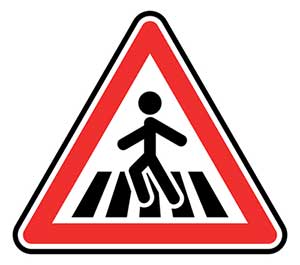19 January 2016
A reminder of the need to critically analyse the conclusions reached by any expert to assess whether they are soundly based or can be challenged...
McCreery v Letson & Others [2015] CSOH.
In the case of McCreery v Letson & Others [2015] CSOH 153, the Pursuer was struck by the First Defender's van when attempting to cross the road. Moments before the accident the Pursuer had disembarked from a bus which had stopped in a lay-by on the opposite side of the road. The Pursuer did not give evidence as she had no memory of the accident. The Pursuer accepted that the court ought to make a finding of contributory negligence for her failure to keep a proper lookout for oncoming traffic.
 The Pursuer's proposition was that the First Defender's driving was negligent as he knew or ought to have known that there was a risk of pedestrians seeking to cross the road or otherwise be on the road and the First Defender ought to have moderated his speed accordingly. The Pursuer’s argument was that the First Defender failed to pay proper attention to a warning sign prior to the lay-by (warning of pedestrians crossing) and failed to react to the presence and movements of the bus, demonstrated by his swerving around the bus.
The Pursuer's proposition was that the First Defender's driving was negligent as he knew or ought to have known that there was a risk of pedestrians seeking to cross the road or otherwise be on the road and the First Defender ought to have moderated his speed accordingly. The Pursuer’s argument was that the First Defender failed to pay proper attention to a warning sign prior to the lay-by (warning of pedestrians crossing) and failed to react to the presence and movements of the bus, demonstrated by his swerving around the bus.
Liability was repudiated on the basis that the First Defender braked when he saw the bus and by the time he saw the Pursuer, he was travelling between 30 to 35mph. The First Defender's evidence was that he was driving well below the 60mph speed limit of the road.
The court was persuaded that there was a foreseeable risk that pedestrians who had disembarked from the bus might cross the road behind the bus. The court held the First Defender did not foresee this risk and took no action in light of this risk and ought to have been aware of the risk given the preceding warning sign highlighting the presence of pedestrians. The court was also satisfied that the First Defender's speed was greater than the speed he gave in evidence of 30 to 35mph. The fact that the First Defender had to swerve in order to get round the bus was suggestive of the fact he was travelling too fast. The court held that the First Defender should have reduced his speed in order to avoid having to swerve around the bus.
On the point of contributory negligence, the court found that the factual circumstances in McCreery were similar to those in Jackson v. Murray and applied the principles set out in Jackson by considering the relative blameworthiness and causal potency of the parties’ actions in its assessment of contributory negligence. In the court’s view, one factor which it ought to have regard to was the potential destructive disparity between the pedestrian and the person driving the vehicle. In light of this, the court apportioned liability on a 50/50 basis.
Separately, the court took issue with the First Defender's road traffic expert’s report. The Pursuer's proposition was that the First Defender's expert was "plainly going out of his way to assist the Defender at all costs". The Pursuer highlighted that the First Defender's expert had failed to narrate extensive proportions of the Highway Code relating to the obligations on a driver, whereas he had quoted in full those applicable to a pedestrian. He failed to mention the presence of the road sign warning of the hospital and the risk of persons crossing the road. Further, the First Defender's expert did not use throw calculations to assess the speed of the First Defender’s vehicle at impact neither did he calculate the speed of the vehicle using co-efficient of friction on the basis of the stop distance.
The court agreed that there was force in the Pursuer’s propositions. The failure to quote the relevant provisions of the Highway Code relative to the duties incumbent on the First Defender when those applying to the Pursuer were quoted in full was not acceptable. Such a presentation did not, for the court, give a full and balanced picture. The expert's failure to mention the warning sign suggested his report was not balanced. The failure to calculate the speed of the First Defender's vehicle by using the co-efficient of friction on the basis of the stop distance was surprising given that it was a well-recognised method for calculating the speed of a vehicle. No real explanation was given as to why it had not been used. Such a calculation would have produced a significantly less favourable speed to the First Defender's position. This demonstrated a lack of balance and even-handedness in the preparation of the report.
This aspect of the judgment, and the court’s criticism of the expert’s report provides a useful reminder to insurers and solicitors of the need to critically analyse the conclusions reached by any expert to assess whether the conclusions of the report are soundly based or whether they can be challenged on the basis of favouring the position of the instructing party.
Mark Hastings, Associate mfh@bto.co.uk T: 0141 221 8012


